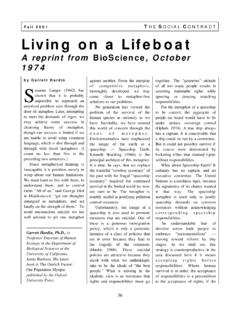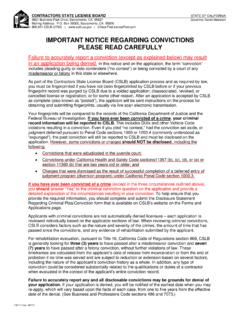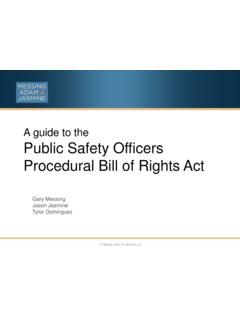Transcription of Women in Prison: Approaches in the Treatment of Our Most ...
1 Women in Prison: Approaches in the Treatment of Our Most Invisible Population by Stephanie S. Covington Institute for Relational Development Center for Gender and justice Women and Therapy Journal (Haworth Press, Vol. 21, No. 1, 1998, ) and Breaking the Rules: Women in Prison and Feminist Therapy. Judy Harden & Marcia Hill (eds). New York: Haworth Press (1998) Overview Some of the most neglected, misunderstood and unseen Women in our society are those in our jails, prisons and community correctional facilities. While Women 's rate of incarceration has increased dramatically, tripling in the last decade, prisons have not kept pace with the growth of the number of Women in prison; nor has the criminal justice system been redesigned to meet Women 's needs, which are often quite different from the needs of men.
2 There are many reasons for the growing numbers of Women in the criminal justice system, but the primary one is the increase in drug-related convictions and the advent of mandatory sentences for these offenses. According to the Federal Bureau of Prisons, over 60% of the Women in their custody are serving sentences for drug offenses. For many states the rate is even higher for alcohol and drug-related crimes. In spite of this, the issues of addicted Women are, for the most part, invisible in the criminal justice system. Historically, Treatment , research and recovery have been based on the male experience, often neglecting Women 's needs. While this neglect has a serious impact on Women and Treatment programs in the free world, the problem is magnified for Women in the criminal justice population.
3 Statistics indicate that for Women there is a high correlation between drug abuse and incarceration and parole/probation violations, and yet our society provides no comprehensive continuum of care for these Women . This paper will discuss a relational model of Treatment that incorporates the multiple issues involved in Women 's recovery. Three theoretical perspectives --addiction, trauma, and Women 's psychological development -- are interwoven to provide the foundation for a model based on the concept of a woman's journey to recovery. This model can be adapted for both the prison population and community-based programs. In summation, the objectives of this paper are: 1. To increase awareness of Women 's lives in the criminal justice system. 2. To discuss a comprehensive and integrated Treatment model (theory of addiction, theory of Women IN PRISON 2 trauma, theory of Women 's psychological development).
4 3. To examine the four areas that Women report as being both most challenging, and their major triggers to relapse: self, relationships, sexuality, and spirituality. 4. To discuss Twelve Step programs for Women . Rising Numbers of Women in the Criminal justice System Since 1980, the number of Women in United States prisons has tripled. During this time, the rate of incarceration for Women has surpassed the male rate during every year but one; and in 1996, the number of Women imprisoned nationally was 69,028 (LeBlanc, 1996). The war on drugs has inadvertently become a war on Women , clearly contributing to the explosive increase in the number of Women who are incarcerated. The 1986 mandatory drug sentencing laws, with their "get tough on crime" philosophy specifying that anyone caught with possession of a drug should automatically be sentenced, were designed to rid society of drug dealers and major players in the illegal drug trade.
5 Unfortunately, this law backfired in the case of Women . The assumption that this law was only sending dangerous males to prison was a false one. Between 1986 and 1991, the number of Women in state prisons for drug offenses increased by 433%, compared to a 283% increase for men (LeBlanc, 1996). Currently, of Women serving time for drug offenses were charged solely with "possession." "Instead of a policy of last resort, imprisonment has become the first-order response for a wide range of non-violent and petty offenses and Women have been disproportionately swept up in this trend" (Bloom, Chesney-Lind, & Owen, 1994, p. 2). To keep up with the high costs of incarceration -- it takes $50,000 per cell to build a new prison and $20,000 per person per year to house offenders -- many states have cut vitally needed social service, educational, and drug/alcohol programs (Raspberry, 1991).
6 Since there is a high rate of recidivism among Women who are convicted for possession or use of drugs, curtailing drug and alcohol recovery programs has proven to be an expensive and illogical move. One of the questions we must ask ourselves when faced with the issues surrounding the growing number of Women in the criminal justice system is whether or not there is always a need for incarceration. In a private conversation, a warden at one of the largest Women 's prisons in the stated that 75% of the Women in her custodial care would be better treated in the community (personal communication, May 1995). Clearly, this would be a more humane and economical solution to the overcrowding of our prisons by Women who have committed nonviolent, petty offenses. Profile of Women in the Criminal justice System Female prison populations differ from their male counterparts in several significant ways.
7 First of all, they are less likely to have committed a violent offense and more likely to have been convicted of a crime involving alcohol, other drugs or property. It is important to point out that many property crimes are economically driven, often motivated by the abuse/addiction of alcohol and other drugs and/or poverty. A 1994 study done in California showed that of Women had been convicted on a drug or property charge versus of men. Men also commit nearly twice the violent crimes that Women do (Bloom, Chesney-Lind, & Owen, 1994). These statistics are consistent with national trends (LeBlanc, 1996). Women are significantly less violent than their male counterparts, and show more responsiveness to prison programs, although they have less opportunity to participate in them than male prisoners do.
8 While men often deal with their anxiety by working their bodies constantly, Women tend to fear the central yard, working out their anxieties with too much sleep, food and prescription pills (LeBlanc, 1996). Women IN PRISON 3 Most female prisoners are poor, undereducated, unskilled, single mothers, and a disproportionate number of them are Women of color. In a study of California prisons, over half of the Women were African American (35%) and Hispanic ( ). One-third were Caucasian and the remaining 13% were made up of other minorities. Of those who had been employed before incarceration, many were on the lower rungs of the economic ladder, with only 37% working at a legitimate job. Twenty-two percent were on some kind of public support, 16% made money from drug dealing and 15% were involved in prostitution, shoplifting or other illegal activities (Bloom, Chesney-Lind, & Owen, 1994).
9 One of the things that these statistics clearly shows is that there are issues of race and class involved in the criminal justice system (Chesney-Lind & Bloom, 1997; Watterson, 1996). For example, there has been a law in the state of Minnesota (recently held unconstitutional) that says first-time users of crack cocaine will receive mandatory four-year sentences, but first-time users of cocaine in its powdered form will receive only probation. Since 92% of those arrested on charges for possession of crack in 1988 were African Americans and 85% of those arrested for possession of powdered cocaine were Caucasian, the law is clearly racist (Raspberry, 1991). When racial and economic factors drive the issue of who will be imprisoned, where is the " justice " in the criminal justice system (Belknap, 1996)?
10 One major health concern in prisons is AIDS. In a study done with 400 female volunteers in a Massachusetts's prison, 35% of the Women tested were HIV positive, compared with 13% of the men. In one California prison, Women who tested positive were placed in a segregated AIDS unit, whether they showed signs of the disease or not (Salholz & Wright, 1990). Two-thirds of incarcerated Women have children under the age of 18 (Smith, 1991). Many feel enormous guilt about being absent from their children s lives and worry about whether they will still have custody of their children when they get out (Bloom & Steinhart, 1993). These and other concerns, including unresolved issues of physical and sexual abuse, lead female inmates to make requests for psychological counseling that far exceed those made by men.









